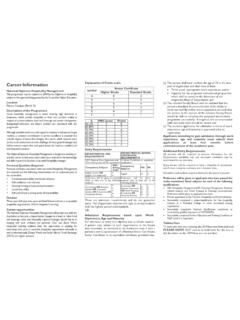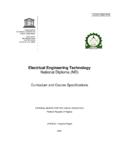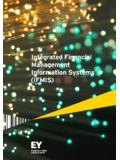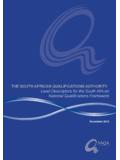Transcription of Information, Communications, and Technology …
1 information , Communications, and Technology (ICT) Skills Curriculum Based on the Big6 Skills Approach to information Problem-Solving By Mike Eisenberg, Doug Johnson and Bob Berkowitz Revised February 2010. Permission is granted for educational use or skills. They found that information skills can be various information Technology skills as part of the reprint of all or parts of this curriculum as integrated effectively when the skills (1) directly learning process. long as the authors and Big6 are properly and relate to the content area curriculum and to The curriculum outlined in this document prominently credited.
2 Classroom assignments, and (2) are tied together in demonstrates how Technology literacy skills can a logical and systematic information process model. There is clear and widespread agreement among the fit within an information literacy skills context public and educators that all students need to be Schools that seek to move away from isolated [American Association of School Librarians, (1998), proficient Technology users. Technology literacy is information Technology skills instruction will (2007); Association of College and Research among the attributes that appear in nearly every set also need to focus on both of these requirements.]
3 Libraries (2000)]. The baseline information of 21st Century Skills. However, while districts Successful integrated information skills programs literacy context is the Big6 process (see sidebar and spend a great deal of money on Technology , there are designed around collaborative projects Eisenberg & Berkowitz, 1988, 1992, 1999, 2000, seems to be only a vague notion of what Technology jointly planned and taught by teachers and 2010). The various Technology skills are adapted literacy really means. Can the student who uses library information and Technology professionals. from the International Society for Technology Technology well enough to play a game, send information Technology skills instruction can and in Education's National Educational Technology e-mail or browse the Web be considered Technology should be embedded in such a curriculum.
4 Teacher- Standards for Students (2007) and the Mankato literate? Will a student who uses Technology in librarians, Technology teachers, and classroom Schools information Literacy Curriculum school only for running tutorials or an integrated teachers need to work together to develop units Guideline. Students might reasonably be expected learning system have the skills necessary to survive and lessons that will include Technology skills, to authentically demonstrate these basic Technology in our society? Is the ability to do basic word information skills, and content-area skills before graduation.
5 Processing sufficient for students entering the curriculum outcomes. Additional Technology literacy competencies that workplace or post-secondary education? A meaningful, unified information Technology may be relevant in some situations include Certainly not. Recent publications by educational literacy curriculum must be more than a laundry knowing: (1) the basic operation, terminology, associations advocate for a more meaningful use of list of isolated skills, such as knowing the parts of and maintenance of equipment, (2) how to use Technology in schools (Partnership for 21st Century the computer, writing drafts and final products with Technology -assisted instructional programs, (3) the Skills, 2008.)
6 Educational technologists clearly a word processor, and searching for information on impact of Technology on careers, society, and culture describe what students should know and be able the Internet. (as a direct instructional objective), and (4). to do with Technology . They advocate integrating computer programming. While specific, articulated skills are important for Technology skills into the content areas, recognize students to learn, the laundry list approach does Defining and describing Technology skills is only that Technology skills should not be taught in not provide an adequate model for students to a first step to assure all our children become isolation, and affirm that separate computer classes.
7 Transfer and apply skills from situation to situation. proficient information and Technology users. Other do not allow students to apply Technology skills in These curricula address the how of Technology critical elements will include a teacher-supported meaningful ways. There is increasing recognition use, but rarely the when or why. Students may scope and sequence of skills, well designed projects, that the end result of Technology literacy is not learn isolated skills and tools, but they would still and effective assessments. Equally essential is knowing how to operate Technology , but rather lack an understanding of how those various skills fruitful collaboration among classroom teachers, to use Technology as a tool for organization, fit together to solve problems and complete tasks.
8 Teacher librarians, and Technology teachers in order communication , research, and problem solving. Students need to be able to use Technology tools to present students with a unified and integrated This revised focus on Technology as a tool is with flexibility, creativity and a genuine purpose. All approach to ensure that all children master the an important shift in conceptual approach and learners should be able to recognize what goals they skills they will need to thrive in an information -rich instructional emphasis. need to accomplish, determine whether Technology future (Eisenberg & Lowe, 1999).
9 Moving away from teaching isolated Technology will help them to do so, and then be able to use The information , Communications, and skills and thereby moving toward an integrated the Technology as part of the process to accomplish Technology (ICT) Skills for information approach is an important step that takes a great their task. Individual Technology skills take on a Problem Solving curriculum presented below deal of planning and effort. Fortunately, we have new meaning when they are integrated within this defines Technology capabilities and identifies a model for doing so. Over the past 30 years, type of information problem-solving process, and associated skills based on the Big6 Skills Approach.
10 Library information and Technology professionals students develop true information Technology The Curriculum describes levels of Technology have worked hard to move from teaching isolated literacy because they have genuinely applied proficiency, and in so doing, promotes the skills and library skills to teaching integrated information concepts basic to information and Technology . In 24 Library Media Connection K-5 6-8 9-12. May/June 2010. an information society, it is essential that students 2. information Seeking Strategies multimedia Technology stations, online terminals, are technologically productive and able to solve scanners or digital cameras).





